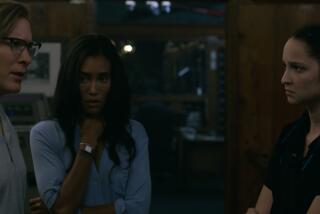George Romero’s ‘The Crazies’
- Share via
George Romero’s “The Crazies” (1973) has always existed in the shadow of his zombie movies, but this epidemic thriller is perhaps the horror maestro’s most provocative exploration of his great theme: the collapse of social order. A new remake, directed by Breck Eisner and also titled “The Crazies,” opens Friday; the original is being issued on Blu-ray by Blue Underground on Tuesday (it is already available on standard-definition DVD).
Back in the crisis-ridden early ‘70s, the film’s queasy premise must have carried more than a ring of real-world plausibility (as it certainly does in our jittery present of viral scares and terror threats). A military plane crashes in western Pennsylvania, releasing a mystery virus into the water supply and turning the nearby residents homicidally insane. The government goes into coverup mode and even considers dropping a bomb on the infected town. The virus, it turns out, was being developed as a biochemical weapon. Soldiers clad in hazmat suits and gas masks sweep in, and before long, the gun-owning citizens start to fight back.
“The Crazies” belongs to the cycle of virus movies that was in vogue in that era. It shares some plot points with Robert Wise’s “The Andromeda Strain” (1971), a slow-burning bio-thriller adapted from a Michael Crichton novel, about a team of scientists battling an alien virus that turns blood into powder.
Two years after “The Crazies,” a young David Cronenberg made “Shivers,” the first of his many body-horror movies, about a sexually transmitted parasite. The quintessential Hollywood genre of the ‘70s -- the all-star disaster movie -- got a bacteriological spin with “The Cassandra Crossing” (1976), which exposes the passengers on a trans-European train to pneumonic plague.
Over the years, virus movies have often resonated with -- or even openly exploited -- the contagion of the moment. The deadly bug in “Outbreak” (1995) is modeled on the Ebola virus that had grabbed headlines a few years earlier. Danny Boyle’s “28 Days Later,” a clear descendant of “The Crazies,” opened in 2003, with anthrax and SARS fresh in the minds of audiences. With fears still lingering over the swine flu pandemic, Steven Soderbergh has announced he’ll direct an epidemic movie called “Contagion.”
The paranoid central conundrum of “The Crazies,” which recurs in the most suggestive disease movies, can be traced back to Don Siegel’s 1956 sci-fi classic “Invasion of the Body Snatchers”: How can you tell who’s infected? (And how do you keep from getting infected?) In “The Crazies,” the action alternates between a scientist (Richard France) scrambling to develop an antidote and a ragtag band of holdouts, led by a fireman (W.G. McMillan) and his pregnant girlfriend (Lane Carroll). But mistrust and fear soon set in among the survivors. The sense of community that typically emerges in a disaster movie is dramatically undermined when the disaster in question is a contagious virus.
As in “Night of the Living Dead” (1968), Romero challenges the sanctity of the most basic unit of society: the nuclear family. In the prologue of “The Crazies,” which echoes the opening of “Night,” a young boy teasingly scares his sister -- only to find that their father, one of the first to be infected by the virus, has killed their mother and is preparing to burn down the house. Among the survivors are a widowed father (Richard Liberty) and his teenage daughter (Lynn Lowry) who, in the grip of madness, succumb to incestuous desires.
Romero’s best movies are often discussed in terms of their respective zeitgeists -- “Night of the Living Dead” as an allegory of late-’60s sociopolitical upheaval, the mall-set “Dawn of the Dead” (1978) as a critique of the ascendant consumer culture. No less than these films, “The Crazies” is a product of its disillusioned moment. But this time capsule of the Vietnam/Nixon years feels as timely as ever today, not least because of Romero’s deep skepticism of authority and his pessimistic view of human nature in extreme situations.
Ambiguous to the end, “The Crazies” doesn’t distinguish between the madness induced by infection and the mass hysteria caused by martial law and the military’s shoot-to-kill measures.
As in so many Romero movies, the most alarming thing here is the fine line between sanctioned and deviant behavior, between Us and Them.
More to Read
Only good movies
Get the Indie Focus newsletter, Mark Olsen's weekly guide to the world of cinema.
You may occasionally receive promotional content from the Los Angeles Times.










